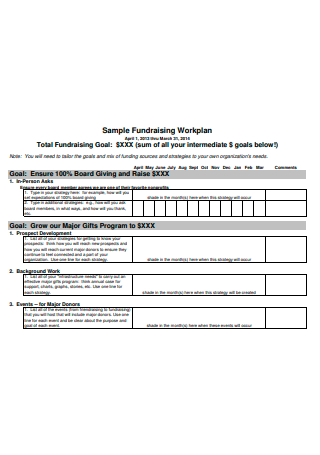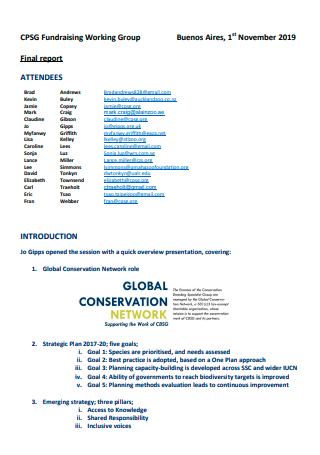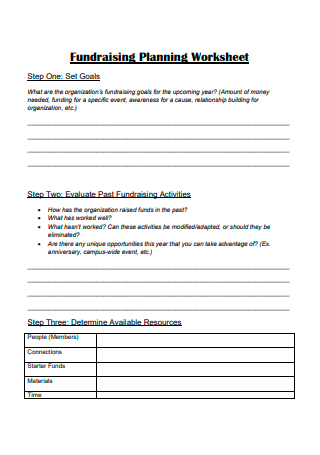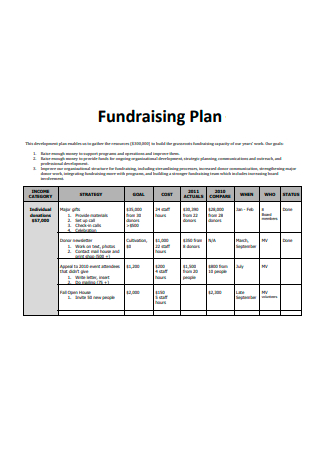+ Sample Fundraising Work Plan
FREE Fundraising Work Plan s to Download
+ Sample Fundraising Work Plan
What Is a Fundraising Work Plan?
What are the Benefits of having a Fundraising Work Plan?
Steps on Creating a Fundraising Work Plan
What are the other examples of fundraising activities?
Is Crowdfunding a form of fundraising?
What are the usual qualities or characteristics of a person needed to join or organize a fundraising event?
What Is a Fundraising Work Plan?
Let’s first talk about what fundraising is. Fundraising is the process of raising financial support or contribution voluntarily through the engagement and the involvement of individuals, the local community, businesses, government agencies, and other charitable foundations. The main purpose of fundraising is to raise a certain amount of financial contribution to support a charity, a cause, or a nonprofit organization. A work plan is a documented planning process with tasks usually assigned to an individual or a group in order to accomplish a certain objective or goal within a given time period. A Fundraising Work Plan documents the strategic plans within a given timeline to raise funds for a certain cause or charity.
Usually done through fundraising events, the fundraising work plan highlights each specific activity, or events, with the goal of an amount of money to be raised, and also assigns each activity to an individual or a group who will be in charge of the activity. Some examples of fundraising activity or events are auctioning, concerts, marathons, non-sport competitions, et cetera. Participants of these events would pay a registration fee that then goes into the collection of money which is raised by the fundraising event organizers.
What are the Benefits of having a Fundraising Work Plan?
Having an event such as fundraising means that all must come together to work on accomplishing the event’s goals. Everyone must be aligned and should have the specific capability of performing the assigned task. Just like a puzzle, every piece should come exactly at the right spot in order to get the big picture. Of course, coming together and working off of a plan has certainly lots of benefits it can offer to the individual member, or to the whole group itself. All for one, one for all, as the saying goes. Read on to find out more what are the benefits of a fundraising work plan.
Steps on Creating a Fundraising Work Plan
Knowing the benefits of working on fundraising events should keep you inspired and motivated to do an event. Next comes the nitty gritty of creating a fundraising work plan. Like all kinds of work plans, a fundraising work plan essentially serves as a roadmap or a guide to the fundraising event organizers. It identifies the objectives, strategies and deadline for achieving the goal. Since it’s a documentation of the planning process for fundraising, everyone is kept aligned and coordinated with the what to dos and the how tos. Below are the common steps used in creating a fundraising work plan.
-
Step 1: Write Down the Goal or the Objective
You can start by creating a table or chart-like format guide. On top of your table, the very top part should be the objective or the goal that needs to be clearly written. Similar to a Mission Statement, for a fundraising goal, write down what is the purpose of doing the fundraising activities. Most significantly, since this is a fundraising goal, write down as much as possible the specific amount of money that you desired to raise. The purpose of writing down the objective in the top part is to stimulate action, to help guide and direct all energy and focus on what needs to be done. In the disabled children’s party example, a sample objective statement could be: “To be able to come up with the resources needed and the funds totaling to $5,000 for the benefit and to be used for the local community’s disabled children’s party scheduled on December 5th, 2021.”
-
Step 2: Identify the Strategies or Fundraising Activities
Filling up the table, write down on the first column the strategies, or fundraising activities, to generate the funds. We have used the house to house solicitation drive as an example. Analyze if the solicitation strategy is enough to raise the funds or not. If not, then you need more fundraising Strategic Plan activities. Another activity is to host a local community marathon. Look for a sponsor, or an Event Sponsorship, who can provide the prize for the marathon event. The prize could be in the form of cash or item. Determine the registration fee amount that every marathon participant needs to pay to join the event. The registration fees that you collected will be added to the total amount of cash for the fundraising goal. Another example of a fundraising Activity Plan is doing a carwash drive or a bake sale. Proceeds from doing the carwash or the bake sale all goes into the pot money for the fundraising goal.
-
Step 3: Listing Down Persons In Charge
Right next to the strategies or fundraising activities column is the name of the individual or groups or persons in charge for the activities. They are tasked with the implementation and monitoring of those activities. They are required to provide constant updates and feedback to the head of the event, as well as they are responsible for the staff, or even the volunteers, that will be helping out in the fundraising activities. These individuals should have the necessary skills and capabilities related to executing the activities, in example, Community Projects. For example, when doing a bake sale, the individual in charge of the bake sale should have a strong knowledge of the local community where the bake sale will be held. That person needs to be familiar with the location, if it’s a good place or not to set up a bake sale. Also, someone with a good connection with the local community should do the trick. Meaning, knowing who are the who’s who in the community. Preferably, it should be someone who knows how to shake hands with local politicians in the area, or someone who’s on a first-name basis with most of the people in that locale. Also, it should be someone who is knowledgeable about getting permits and other requirements from the local government to set up the bake sale.
-
Step 4: Tagging a Timeline
Next to the persons in charge column is the timeline. The timeline can be done in two separate columns; one for the start date, and one for the end date. The timeline is the period covered for the fundraising activities. This is the allotted period, and as much as possible should be strictly adhered to. The main purpose of the timeline is to maintain the tone of urgency of the whole purpose of the fundraising which, as an example, is the scheduled party date for the disabled children.
-
Step 5: Identifying Needed Resources
The next column is for the resources, such as manpower, equipment or tools, needed in implementing the fundraising activities. In the example of a bake sale, usual resources needed are, of course, the cakes, cookies and pastries, or who will be the ones to voluntarily bake and donate these, or the sponsor for the cakes to be sold. Another resource for this activity are the assigned individuals who will be looking after the bake sale. The bake sale stand or stall and other equipment needed for the installation of the bake sale is another resource. Also, the registration and permits needed to set up the bake sale are another set of resources.
-
Step 6: Results Monitoring
The last step, or the last column needed when coming up with a fundraising work plan is allotted for the results monitoring. This is the part where you put the result of the fundraising activities, or mainly the amount of money that was generated as a result of those activities. The purpose of this is to monitor how near or far you are in reaching the fund goal for, in this example, the disabled children’s party. This will allow you to make some necessary changes in your next set of activities, if you see that there is a need to do more aggressive fundraising activities, or if you can start to slow it down seeing that you’re almost near in reaching the goal.
FAQs
What are the other examples of fundraising activities?
Aside from the usual solicitation and sales drives, you can also do some marketing campaigns. Example of which is through digital marketing, such as email marketing, social media marketing, newsletter marketing, or blog posts marketing. Another activity is through auctioning, where volunteers or sponsors would put up their personal items to be sold at an auction. Proceeds from the sale of the items goes to the collected amount for the fundraising goal.
Is Crowdfunding a form of fundraising?
Yes. Crowdfunding is considered as a form of fundraising, wherein it comes up with funds for a particular cause or project through donations coming from lots of people. These are usually donations given in small amounts, but eventually accumulates as more and more people start to donate. Crowdfunding is often done through social media, thereby making it easy when it comes to reaching more people or supporters.
What are the usual qualities or characteristics of a person needed to join or organize a fundraising event?
Someone who has passion tops the list of characteristics. It is important for a person to be passionate about the fundraising project, to have the right heart or motivations in place, or else the whole fundraising structure will fall due to its lackluster energy. Another important characteristic is the knowledge and skill in doing events, particularly fundraising events. Confidence and patience are another two important characteristics. The right amount of confidence is needed when approaching people to ask for donations, and the right amount of patience as well because fundraising events take time before the realization of their goals.
Doing fundraising events should not be an intimidating task. Yes, it can be challenging, but nevertheless, still, a worthwhile challenge. Being able to help other people, fund a charitable cause, contribute to the betterment of the unfortunate should be enough to motivate and inspire you to keep on moving forward. Having the right goal, the right strategies, and the right timeline in place would certainly make your fundraising activities successful. Also, with the help of a good and effective fundraising work plan, reaching that goal will be a cinch. Download our fundraising work plan template now, and see how easy it is to plan and work your way through towards achieving your fundraising goal!




